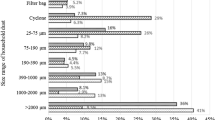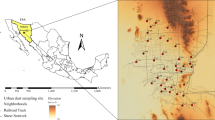Abstract
Over the past decade, ambient air particulate matter (PM) has been clearly associated with adverse health effects. In Brazil, small and poor communities are exposed to indoor dust derived from both natural sources, identified as blowing soil dust, and anthropogenic particles from mining activities. This study investigates the physicochemical and mineralogical composition of indoor PM10 dust samples collected in Minas Gerais, Brazil, and evaluates its cytotoxicity and inflammatory potential. The mean PM10 mass concentration was 206 μg/m3. The high dust concentration in the interior of the residences is strongly related to blowing soil dust. The chemical and mineralogical compositions were determined by ICP-OES and XRD, and the most prominent minerals were clays, Fe-oxide, quartz, feldspars, Al(hydr)oxides, zeolites, and anatase, containing the transition metals Fe, Cr, V, Ni, Cu, Zn, Ti, and Mn as well as the metalloid As. The indoor dust samples presented a low water solubility of about 6 %. In vitro experiments were carried out with human lung alveolar carcinoma cells (A549) to study the toxicological effects. The influence of the PM10 dust samples on cell viability, intracellular formation of reactive oxygen species (ROS), and release of the pro-inflammatory cytokine IL-8 was analysed. The indoor dust showed little effects on alamarBlue reduction indicating unaltered mitochondrial activity. However, significant cell membrane damage, ROS production, and IL-8 release were detected in dependence of dose and time. This study will support the implementation of mitigation actions in the investigated area in Brazil.






Similar content being viewed by others
References
Chen, L. C., & Lippmann, M. (2009). Effects of metals within ambient air particulate matter (PM) on human health. Inhalation Toxicology, 21, 1–31.
Deschamps, E., Matschullat, J. (Eds.), (2011). Arsenic: Natural and anthropogenic. In Bundschuh et al. (Ser. eds.), Arsenic in the environment 4 (209 p.). Balkema: CRC Press
Diabaté, S., Bergfeldt, B., Plaumann, D., Übel, C., & Weiss, C. (2011). Anti-oxidative and inflammatory responses induced by fly ash particles and carbon black in lung epithelial cells. Analytical and Bioanalytical Chemistry, 401, 3197–3212.
Diabaté, S., Mülhopt, S., Paur, H. R., & Krug, H. F. (2008). The response of a co-culture lung model to fine and ultrafine particles of incinerator fly ash at the air-liquid interface. Alternatives to Laboratory Animals, 36, 285–298.
Dockery, D. W. (2009). Health effects of particulate air pollution. Annals of Epidemiology, 19, 257–263.
Fritsch-Decker, S., Both, T., Mülhopt, S., Paur, H. R., Weiss, C., & Diabaté, S. (2011). Regulation of the arachidonic acid mobilization in macrophages by combustion-derived particles. Particle and Fibre Toxicology, 8, 23.
Gordon, T., & Fine, J. M. (1993). Metal fume fever. Occupational Medicine, 8, 504–517.
Kim, Y. M., Reed, W., Wu, W., Bromberg, P. A., Graves, L. M., & Samet, J. M. (2006). Zn2+-induced IL-8 expression involves AP-1, JNK, and ERK activities in human airway epithelial cells. American Journal of Physiology Lung Cellular and Molecular Physiology, 290, L1028–L1035.
Kuschner, W. G., D’Alessandro, A., Wong, H., & Blanc, P. D. (1997). Early pulmonary cytokine responses to zinc oxide fume inhalation. Environmental Research, 75, 7–11.
Lenz, A. G., Karg, E., Lentner, B., Dittrich, V., Brandenberger, C., Rothen-Rutishauser, B., et al. (2009). A dose-controlled system for air-liquid interface cell exposure and application to zinc oxide nanoparticles. Part Fibre Toxicol, 6, 32.
Lin, W. S., Xu, Y., Huang, C. C., Ma, Y. F., Shannon, K. B., Chen, D. R., et al. (2009). Toxicity of nano- and micro-sized ZnO particles in human lung epithelial cells. Journal of Nanoparticle Research, 11, 25–39.
Perez-Padilla, R., Schilmann, A., & Riojas-Rodriguez, H. (2010). Respiratory health effects of indoor air pollution. The International Journal of Tuberculosis and Lung Disease, 14, 1079–1086.
Pope, C. A., Ezzati, M., & Dockery, D. W. (2009). Fine-particulate air pollution and life expectancy in the United States. New England Journal of Medicine, 360, 376–386.
Schulze, C., Kroll, A., Lehr, C. M., Schäfer, U. F., Becker, K., Schnekenburger, J., et al. (2008). Not ready to use-overcoming pitfalls when dispersing nanoparticles in physiological media. Nanotoxicology, 2, 51–61.
Sharma, V., Anderson, D., & Dhawan, A. (2012). Zinc oxide nanoparticles induce oxidative DNA damage and ROS-triggered mitochondria mediated apoptosis in human liver cells (HepG2). Apoptosis, 17, 852–870.
Valko, M., Rhodes, C. J., Moncol, J., Izakovic, M., & Mazur, M. (2006). Free radicals, metals and antioxidants in oxidative stress-induced cancer. Chemico-Biological Interactions, 160, 1–40.
Acknowledgments
The authors thankfully acknowledge financial support from the Brazilian Research Foundation of Minas Gerais—FAPEMIG and also from KIT Campus South; Dr. Utz Kramar for the ED-XRF measurements and Dr. Stefan Norra and Nina Schleicher for the PM10 samplers. We also thank Prof. Dr. Matschullat for the support during the sampling campaign and Dr. Rodrigo Estevão Texeira for the precious comments and suggestions.
Conflict of interest
The authors declare that they have no conflict of interest.
Author information
Authors and Affiliations
Corresponding author
Rights and permissions
About this article
Cite this article
Deschamps, E., Weidler, P.G., Friedrich, F. et al. Characterization of indoor dust from Brazil and evaluation of the cytotoxicity in A549 lung cells. Environ Geochem Health 36, 225–233 (2014). https://doi.org/10.1007/s10653-013-9560-9
Received:
Accepted:
Published:
Issue Date:
DOI: https://doi.org/10.1007/s10653-013-9560-9




